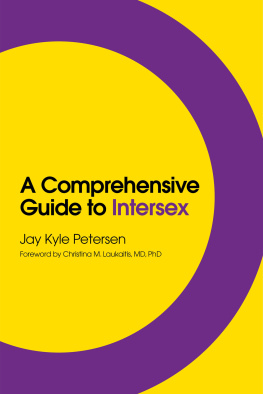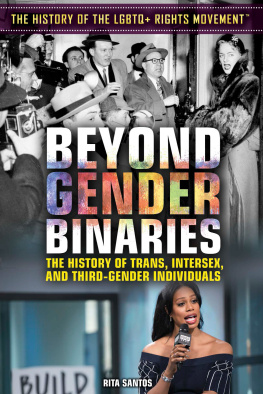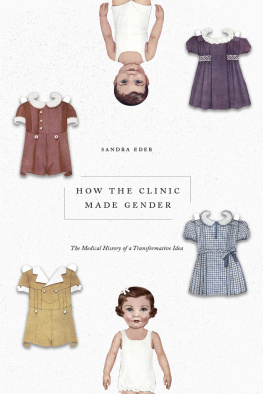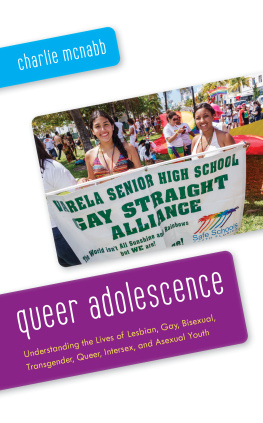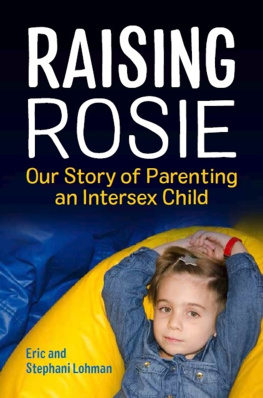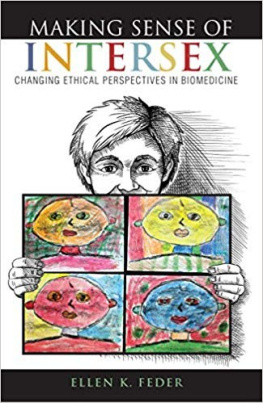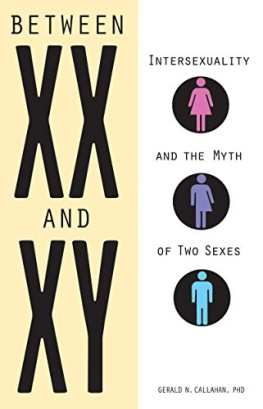Contents

A Comprehensive Guide to
Intersex
Jay Kyle Petersen
Foreword by Christina M. Laukaitis

Contents
Note on Terminology
I have selected the term intersex to be used throughout much of this book. Intersex is an umbrella term used to describe a wide range of natural variations in sex characteristics that do not seem to fit typical binary notions of male or female bodies (interACT and Lambda Legal 2018; United Nations 2017). Intersex develops in the womb. Intersex traits can be so subtle that in some cases diagnosis may be difficult (Laukaitis personal correspondence). Some intersex traits are visible at birth while some are not. Some intersex characteristics do not make themselves known until puberty. Some individuals may not become aware that they have a specific intersex variation until they reach adulthood.
Intersex traits, characteristics and specific variations belong to the spectrum of the human body. It is important to note that intersex characteristics are not your gender or Gender identity; they are on a different spectrum. Most often in the Western society, people assume what gender someone will be or what their gender identity is based on the sex they were assigned at birth. For example, if you were assigned female at birth, many assume you will grow up feminine and identify as a woman. In addition, they usually associate stereotypical behaviors based on the gender roles they assign you. It cannot be stated enough that sex assigned at birth and gender identity are two different aspects of ourselves and two different spectrums.
The terms intersex and transgender have also been confused by many people. Though there are similarities between people with intersex traits and transgender people, such as the spectrums of core gender identity, of who one is attracted to, and self-expression, according to interACT and Lambda Legal (2018) the terms should not be conflated. The authors continue by stating, intersex refers to inborn sex characteristic variations in physical bodies that do not seem to fit typical binary notions of male or female, whereas transgender refers to people whose gender [identity] differs from their assigned or presumed sex at birth. For example, I am a woman (core gender identity) born in a physical male body or I am a man (core gender identity) born inside a physical female body. To review, the physical body of a transgender individual has no inborn intersex traits.
Disorders of Sex Development (DSD), is another term some have used to describe intersex characteristics. This term has not been widely accepted by many individuals in the intersex community because they feel it is pathologizing. I agree and reject this term. Instead, Differences of Sex Development has been created as a substitute with some preferring this term, including a growing number of professionals.
Across the globe we find a wide variety of names and expressions used by individuals born with intersex traits to describe themselves. Some choose the name of the specific variation; some prefer the umbrella term intersex; others prefer a name which describes their body, mind, and spirit; others see intersex as an identity and still others as the experience itself. Some Indigenous and non-Western cultures use language specific names for individuals born with intersex characteristics. For example: Bissu Indonesia (Graham 2007); Kwolu-aatmwol Papua New Guinea (Herdt 1999); Khuntha Islam (Yusef 2017); and North American Native Indian Cherokee Asegi and Navaho Nedleeh n
Infants born with intersex characteristics cannot yet verbalize their identity. In addition, children may lack adequate language capacity to express their identity and older children may not feel safe to express their identity until puberty. Some teens and adults may simply choose not to disclose their identity, preferring privacy instead, other teens and adults may not feel safe to speak their identity at all while some individuals born intersex speak freely and openly about their identity. Professionals themselves may not agree on what intersex characteristics are (Blackless et al. 2000; Sax accessed 07.09.2019). The terms hermaphrodite and pseudohermaphrodite, were terms once used frequently to describe intersex characteristics and bodies but they have fallen out of favor due to being seen as pejorative by many in recent years. Certainly many individuals born with intersex traits and a growing number of professionals view these later two terms as unacceptable descriptors conveying stigma.
Language and identities by individuals born with intersex traits constitute a rich dynamic and expansive vocabulary. Autonomy to choose whichever identifier the intersex individual uses is paramount. This is a part of who we are, how we were born, and terms we use to identify are ours to determine, no one elses to assume. Its not your responsibility to label another or decide the intersex self-identifiers for an individual.
I have chosen to use the umbrella term intersex throughout much of this book, to convey in the broadest possible inclusive manner, this dynamic vocabulary honoring individual and cultural autonomy. Finally, when you see the term intersex in this book, remember I am referring to the spectrum of the human body and not to the spectrums of core gender identity, attraction, self-expression, or the term transgender.
Jay Kyle Petersen, MSW
Quick Reference Terms
Sex Assigned at Birth - the sex you are labeled when born (or even in utero) often based on physical anatomy; includes terms male, female, or intersex. (Planned Parenthood)
Gender - Gender refers to the attitudes, feelings, and behaviors that a given culture associates with a persons sex assigned at birth. Behavior that is compatible with cultural expectations is referred to as gender-normative; behaviors that are viewed as incompatible with these expectations constitute gender non-conformity. (American Psychological Association)
Gender Identity - a persons private sense of, and subjective experience of, their own gender; their core sense of self. Includes terms boy, girl, man, woman, being gender expansive, nonbinary, genderfluid, or any other gender identity that may be expressed. In other words, how you, in your own mind, think of yourself. (American Psychological Association)
Transgender or Trans - Used as an umbrella term and also as a specific description of an identity. A person who lives or self-identifies as a member of a gender identity other than that expected based on sex assigned at birth. (American Psychological Association)
accessed 2/28/2020
accessed 2/28/2020
accessed 2/28/2020
accessed 2/28/2020
Foreword
The question What is my biological sex? arises periodically in my clinical genetics practice. Jay has taught me how to address it. Without blushing. That sounds trivial, but is not. Biological sex and gender identity are two separate concepts and both are central to our interactions as human beings, but it is difficult to be comfortable interacting with someone whose biological sex does not fit into an expected category. Just because there are biological reasons that someone is not binary does not make it less uncomfortable. What Jay has done is to ask penetrating questions about causes of his own biological intersex anatomy and the sex he was assigned when he was born, based on the sex the doctor or his parents declared him to be at that time. Working together to seek the answers has taught me about both the biological and the cultural implications of intersex. The goal of this book is to expand this discussion to include people exploring intersex from many perspectives.

